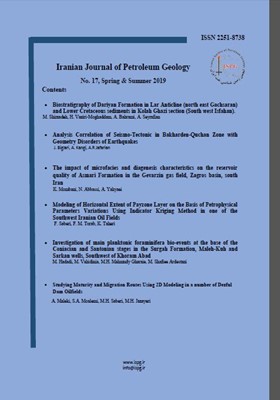Modeling of Horizontal Extent of Pay zone Layer on the Basis of Petrophysical Parameters Variations Using Indicator Kriging Method in one of the Southwest Iranian Oil Fields
Subject Areas : پترو فیزیک
Farnaz Saberi
1
,
Farhad Mohammad Torab
2
,
Kioumars Taheri
3
*
![]()
1 - M.Sc. in Petroleum Engineering Exploration, Department of Mining and Metallurgical Engineering, Yazd University, Yazd, Iran
2 - Associate Professor, Department of Mining and Metallurgical Engineering, Yazd University, Yazd, Iran
3 - M.Sc. in Petroleum Engineering Exploration, Department of Mining and Metallurgical Engineering, Yazd University, Yazd, Iran
Keywords: Petrophysical ParametersGeostatisticsIndicator KrigingProduction ZoneSouthwest Oil basin,
Abstract :
Determining the position of the production zone is one of the best ways to reduce drilling costs as well as quick access to the reservoir and optimal production of hydrocarbon resources. The purpose of this study, is to estimate the porosity, water saturation and thickness of an oil field in Iran’s southwestern Basin , and ultimately to reach the production zone. Therefore, according to the data obtained from 76 wells of this field, variation of reservoir petrophysical parameters were modeled with variogram operation and using Geostatistical methods. By using ordinary Kriging method, the values of the parameters were estimated in the whole field. Subsequently, by using the indicator kriging method, the field boundaries were separated in order to obtain the exact area of the oil zone and the volume of oil in place and finally by considering the 80% probability level, The definite boundary of the presence of the production zone was determined in the block model and In this zone the volume of reservoir’s hydrocarbon was estimated about 147/5 million cubic foot.

